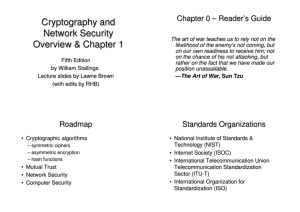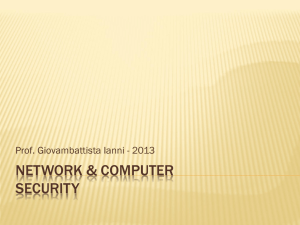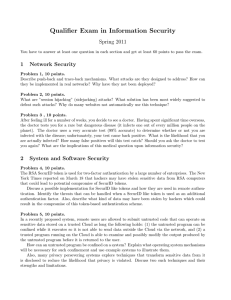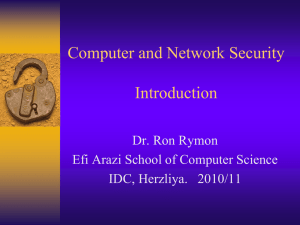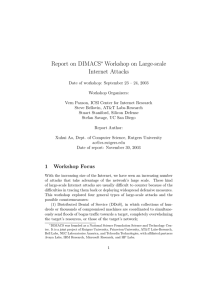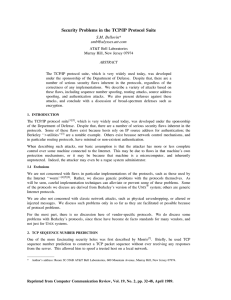pptx
advertisement
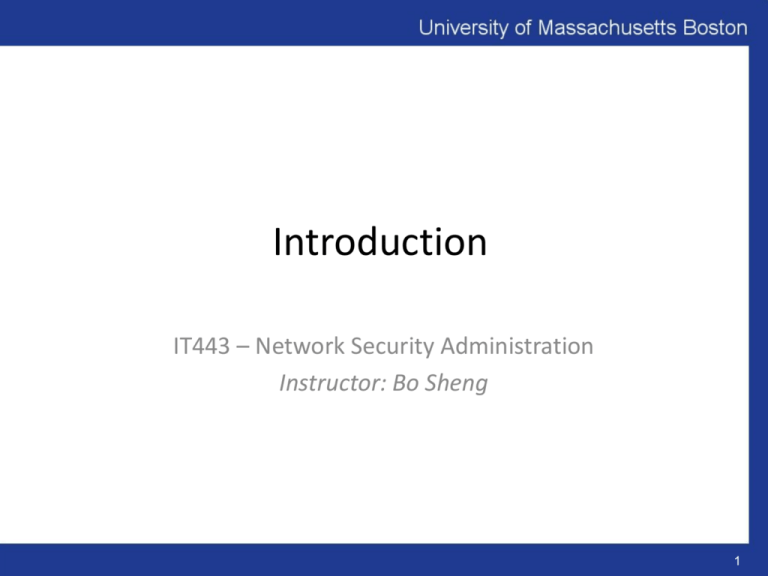
Introduction IT443 – Network Security Administration Instructor: Bo Sheng 1 Basic Information • Location and time – S-3-028, – Tuesdays and Thursdays 5:30~6:45pm • Instructor (Bo Sheng) – Bo.Sheng@umb.edu – 617-287-6468 – Office: S-3-167 – Office hours: Tu & Th, 2~4pm 2 Course Outline • Network Basics – Network layers, headers, services, … – TCP/IP, MAC, DNS, ARP, … • Cryptography Basics – Secret key encryption, Public key encryption, Hash function – Doesn’t cover theoretical foundation • Authentication – Password, challenge/response, mutual authentication, … 3 Course Outline • Public Key Infrastructure – PKI architecture, certificates, … • IPsec – Secure IP layer protocol • SSL/TLS – Secure transport layer protocol • Firewall – Prevent attacks, iptables, … 4 Course Outline • Intrusion Detection System – Host-based IDS and network-based IDS • Email Security • Wireless security / Worm (backup) – Rouge AP attacks, WEP crack, Worm propagation/detection, … 5 Course Work • 6~7 lab assignments (70%) – Team of 2 students – Lab report • Final exam (30%) • Lecture + Lab – Virtual machines 6 Lab Outline • Understanding network packets – IP prefix, DNS service • Encryption/decryption – Conduct file encryption (openssl) – Distinguish cryptographic algorithms • Password cracking – Dictionary attack, john-the-ripper • Network attacks – SYN flood, ARP poisoning 7 Lab Outline • Implementing certificate – Set up https service • Configuring a firewall – iptables • System monitoring – Remote logging • Intrusion detection – Aide and Snort • SQL injection (backup) 8 Other Info • Course web page – http://www.cs.umb.edu/~shengbo/teaching/it443.html • Prerequisite – IT341 – If you take IT341 later, you will lose the credits of this course. 9 Policies • Lab reports – Partial points will be given, but no later submissions are accepted. • Honor code • No makeup exam • Accommodations – Ross Center for Disability Service • Campus Center Room 211 • 617-287-7430 10 Information • Door code: 254646* • Login: Your windows account • If you use your own laptop, install – Vmware workstation 10 • key: J0283-LK3E0-K8X65-032RH-2ER14 – Virtualbox – Image: NSF SEED project • \\weblab00\users\shengbo\documents\it443 11 Introduction to Network Security • Security Breaches – http://www.informationisbeautiful.net/visualizations/worlds-biggest-databreaches-hacks/ • Symantec Threat Explorer – http://us.norton.com/security_response/threatexplorer/index.jsp • Email Spam 12 Introduction to Network Security • Security threats – Malware: Virus, worm, spyware – Spam – Botnet – DDoS attacks – Phishing – Cross-site scripting (XSS) –… 13 Contributing Factors • Lack of awareness of threats and risks of information systems – Security measures are often not considered until an Enterprise has been penetrated by malicious users • Wide-open network policies – Many Internet sites allow wide-open Internet access • Lack of security in TCP/IP protocol suite – Most TCP/IP protocols not built with security in mind • Complexity of security management and administration • Software vulnerabilities – Example: buffer overflow vulnerabilities • Cracker skills keep improving 14 Security Objectives (CIA) 15 Security Objectives (CIA) • Confidentiality — Prevent/detect/deter improper disclosure of information • Integrity — Prevent/detect/deter improper modification of information • Availability — Prevent/detect/deter improper denial of access to services provided by the system 16 OSI Security Architecture • ITU-T X.800 “Security Architecture for OSI” • Defines a systematic way of defining and providing security requirements • It provides a useful, if abstract, overview of concepts we will study 17 Aspects of Security • 3 aspects of security: – security attack • Any action that compromises the security of information owned by an organization – security mechanism • A process that is designed to detect, prevent, or recover from a security attack – security service • Counter security attacks: make use of one or more security mechanisms to provide the service 18 Threat Model and Attack Model • Threat model and attack model need to be clarified before any security mechanism is developed • Threat model – Assumptions about potential attackers – Describes the attacker’s capabilities • Attack model – Assumptions about the attacks – Describe how attacks are launched 19 Passive Attacks 20 Active Attacks 21 Security Mechanism (X.800) • Specific security mechanisms: – encipherment, digital signatures, access controls, data integrity, authentication exchange, traffic padding, routing control, notarization • Pervasive security mechanisms: – trusted functionality, security labels, event detection, security audit trails, security recovery 22 Security Service • Enhance security of data processing systems and information transfers of an organization • Intended to counter security attacks • Using one or more security mechanisms • Often replicates functions normally associated with physical documents – For example, have signatures, dates; need protection from disclosure, tampering, or destruction; be notarized or witnessed; be recorded or licensed 23 Security Service • Authentication - assurance that communicating entity is the one claimed • Access Control - prevention of the unauthorized use of a resource • Data Confidentiality –protection of data from unauthorized disclosure • Data Integrity - assurance that data received is as sent by an authorized entity • Non-Repudiation - protection against denial by one of the parties in a communication • Availability – resource accessible/usable 24 • Check network connection – ping google.com – sudo apt-get update • Log out 25
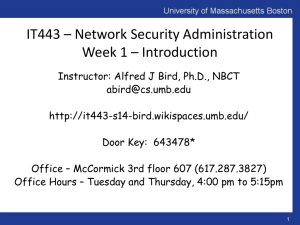

![Systems Assurance [Opens in New Window]](http://s3.studylib.net/store/data/007522633_2-e364c8f93e26286779d02c826b323ed6-300x300.png)
